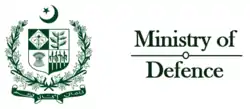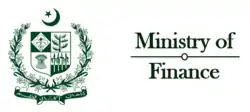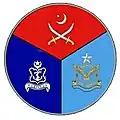| وزارت دفاع | |
 | |
| Agency overview | |
|---|---|
| Formed | August 14, 1947 |
| Jurisdiction | Government of Pakistan |
| Headquarters | Pakistan Secretariat No. II in Adam Jee Road, Rawalpindi, Punjab, Pakistan. |
| Employees | 800,000 (active)[1] 1,000,000 (reserves)[2] 1,000,000 (paramilitary)[3] 200,000+(civilian) |
| Annual budget | US$25.4 billion (2023)[4] |
| Minister responsible |
|
| Agency executives |
|
| Website | www |
The Ministry of Defence (Urdu: وزارت دفاع, Trans. Wazarat-e-Difa, abbreviated as MoD), is an executive ministry of the federal Government of Pakistan, tasked in defending national interests and territorial integrity of Pakistan.[5] The MoD oversees mission execution of its policies and supervises all agencies of the government directly related to the national security and the Pakistan Armed Forces.[6]
The existence and functions of the ministry are statutorily defined in Part XII, Chapter II of the Constitution of Pakistan with Minister of Defence being its head who reports directly to Prime Minister of Pakistan.[7]
The responsibilities for procurement, production and disposal of equipment were transferred in 2004 to the Ministry of Defence Production. The Ministry of Defence is one of the largest federal ministries of the Government of Pakistan in terms of budget as well as staff.[8][9]
History
The Ministry of Defence (Urdu: وزارت دفاع; Transliteration: Wazarat-e-Difa) was created on 14 August 1947 from the partitioning of Ministry of Defence of India, with Prime Minister of Pakistan Liaquat Ali Khan taking the additional charge as first Minister of Defence.: 97 [10]
From 1947 until 1971, the MoD was highly centralized with decision-making process and defense policies was solely depended on the Army GHQ in Rawalpindi, Punjab.: 35–37 [11] In 1973, the Constitution of Pakistan provided the legal existence and its concise functionary role in defined Part XII, Chapter II, which strongly supported the civilian control of the military to prevent any misadventures affecting the national integrity of Pakistan.: 38 [11]
Since 1973, many reforms have been carried out to strengthened the role of the ministry and execute its mission and scopes.: 38 [11] From 1947 until 2004, the MoD also oversaw the roles of military expenditures and procurement when the Ministry of Defence Production was created.[12] Unlike the other federal ministries, the MoD is still based in Rawalpindi, near the vicinity of Army GHQ and the JS HQ.[13]
In its current mission parameters, the MoD is works to execute the defence policy and coordinates its functions among the different agencies and contractors relating to defence.[14] The MoD also grants security clearances under British-styled Official Secrets Act to those involved in programs relating to MoDP and MoE.[15]
Organizational structure
The Minister of Defence, appointed by the Prime Minister of Pakistan, is an elected member of Parliament of Pakistan who is a head of the ministry per accordance to the Constitution.[16] The Defence minister is assisted by the Secretary of Defence and Parliamentary Secretary of Defence to oversee the bureaucratic matters and issues relating to administering the civil affairs between the military and the Prime Minister's Secretariat in Islamabad.: 41 [11]
The Ministry of Defence is composed of Secretariats of Army, Air Force, and Navy, the Joint Chiefs of Staff Committee, tri-services headquarters (Army GHQ, AHQ and NHQ), secretary from finance ministry for military financing, and joint secretaries from each secretariats of army, air force, and navy.: 41 [11][17][18] The following is a simplified representation of the MoD's senior leadership:[19]
- Military Secretariats of the Ministry of Defence
 Secratariat-I Army
Secratariat-I Army Secratariat-II Air Force
Secratariat-II Air Force Secratariat-III Navy
Secratariat-III Navy
- Attached formations of the Ministry of Defence





.png.webp)
 Military Accounts Department, MoF
Military Accounts Department, MoF
Restructuring
In the past, the Aviation Division (established in 2013) and Ministry of Defence Production (established in 2004) were also part of the MoD.: 41 [11] The Special Communications Organization was also part of the MoD when it was separated and attached to the Ministry of Telecommunication in 1976. From 1972 until 2000, the MoD held responsibility of the security parameters and development of the nuclear weapons, which also had control over the weapons testing laboratories till when the National Command Authority was established and is now vested with direction provided by the Ministry of Energy (MoE).
The MoD does not have control over the uniformed paramilitary organizations such as Army Rangers, Frontier Corps, Coast Guards, and GB Scouts which are managed by the Ministry of Interior (MoI) despite the appointments are direct from the Army GHQ in Rawalpindi. The Strategic Plans Division Force, which is also uniformed with appointments made from the military, is under the Ministry of Energy.[20]
See also
References
- ↑ "India vs Pakistan: Military strength and arsenal". Al Jazeera. 26 February 2019. Retrieved 2 July 2019.
- ↑ "Global Fire Power Index 2019: Military strength and arsenal". Global Fire Power. 30 June 2019. Retrieved 7 July 2019.
- ↑ "Paramilitary Force Strength by Country (2021)". Global Fire Power.
- ↑ "Military expenditure by country, in constant (2017) US$ m., 1988-2018" (PDF). Stockholm International Peace Research Institute. 2019. Retrieved 2 July 2019.
- ↑ "MoD's mission". mod.gov.pk. Retrieved 15 July 2023.
- ↑ "What We Do". mod.gov.pk. Retrieved 15 July 2023.
- ↑ http://www.pakistani.org/pakistan/constitution/part12.ch2.html Part XII, Chapter II (Miscellaneous)
- ↑ "Pakistan hikes defence budget by over 11%; allocates Rs 1,523 billion". Retrieved 15 July 2023.
- ↑ Kiani, Khaleeq (2 December 2022). "Defence ministry seeks more funds to fight inflation". DAWN.COM. Retrieved 15 July 2023.
- ↑ Cheema, Pervaiz I.; Riemer, Manuel (22 August 1990). Pakistan's Defence Policy 1947-58. Springer. ISBN 978-1-349-20942-2. Retrieved 15 July 2023.
- 1 2 3 4 5 6 Cheema, Pervaiz Iqbal (2002). The Armed Forces of Pakistan. NYU Press. ISBN 978-0-8147-1633-5. Retrieved 15 July 2023.
- ↑ "Ministry of Defence Production". modp.gov.pk. Retrieved 15 July 2023.
- ↑ "Address of MoD". Retrieved 15 July 2023.
- ↑ 1, Ibid
- ↑ 1, Ibid
- ↑ 2, Ibid.
- ↑ "Organogram of MoD". Retrieved 15 July 2023.
- ↑ http://202.83.164.29/mod/frmDetails.aspx?opt=misclinks&id=19
- ↑ http://202.83.164.29/mod/frmDetails.aspx?opt=misc&id=4
- ↑ Luongo a, Kenneth N.; Salik, Naeem. "Building Confidence in Pakistan's Nuclear Security-- Arms Control Association". www.armscontrol.org. Retrieved 15 July 2023.